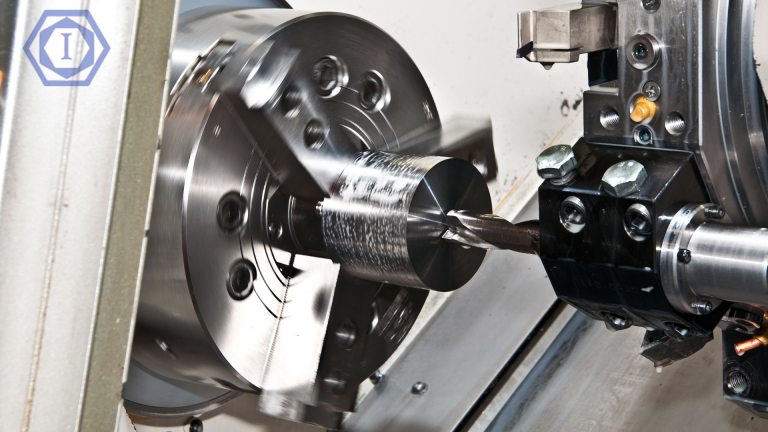MANUFACTURING INC.

CNC turning is one of the most widely used methods in modern manufacturing. It’s especially good at creating cylindrical parts with high accuracy and consistency. Many machines in industries like automotive, aerospace, and electronics rely on parts such as shafts and rods, most of which are made using the turning process because it’s ideal for producing parts that are symmetrical around an axis.
In this post, we’ll explain how CNC turning works and highlight the types of parts it can produce.
CNC turning is a machining process where a cutting tool shapes a rotating piece of material, usually metal or plastic, into a precise part. The machine used for this is called a lathe, which spins the workpiece at high speed. As the workpiece rotates, the cutting tool moves in a straight line, gradually shaving off material to form the final shape. This process continues until the part reaches its exact dimensions, as defined in the design.
There are several different methods within CNC turning, including taper turning, straight turning, external grooving, and profiling. Each of these techniques is suited for producing specific shapes, such as cones, straight cylinders, grooves, or curves. No matter which method is used, CNC turning typically relies on a single-point cutting tool designed to work with the unique properties of each material.
Modern CNC turning machines are also very flexible. In addition to basic turning operations, they can be equipped with tools for secondary processes like drilling or boring, allowing multiple operations to be completed in one setup. This not only improves efficiency but also ensures higher precision in the finished part.
CNC turning is incredibly versatile and supports a wide range of industries. Here are a few common types of parts made using this method:
CNC turning is a versatile and precise manufacturing method that is widely used across various industries. Its ability to create consistent, high-precision cylindrical parts makes it suitable for both industrial and specialized applications. Below are the main categories of parts commonly produced using CNC turning:
CNC turning is frequently used in industries such as automotive, aerospace, and heavy machinery, where durability and accuracy are critical. This process is ideal for manufacturing parts like:
These components are typically made from strong and reliable metals such as:
Thanks to its precision, CNC turning ensures that each part meets strict quality standards, which is essential in these demanding industries.
Acrylic is another material that works exceptionally well with CNC turning, particularly when a smooth finish and visual appeal are required. This makes it popular in both commercial and decorative applications, such as:
The ability to produce both functional and aesthetic parts makes acrylic turning a great choice in sectors, where design matters just as much as performance.
In electronics manufacturing, CNC turning plays a crucial role in creating small, high-precision parts that fit into compact devices. These include:
As electronic devices continue to get smaller and more complex, the need for precision machining grows. CNC turning, with its computer-controlled accuracy, ensures that every part is produced to the exact dimensions required—supporting performance, reliability, and efficiency.

Whether you’re in manufacturing, product design, research and development, or even creative fields, CNC turning offers a reliable and flexible solution. Its ability to work with various materials and produce parts with consistent quality makes it a trusted process for producing everything from industrial components to delicate, custom designs.
As CNC technology continues to advance, more and more manufacturers benefit from the speed, precision, and cost-effectiveness of CNC Turning. At Interscope Manufacturing Inc., we are committed to providing our customers with superior quality CNC machined parts and prototypes. With more than 35 years of experience, we have the in-depth knowledge and state-of-the-art equipment necessary to produce exceptionally accurate parts within even the most stringent specifications.
At Interscope Manufacturing Inc., we make it a point to incorporate the latest automated technology for every step of our manufacturing process. From CAD software to cutting-edge CNC systems, our engineers and technicians will take your project from conceptualization through production.
If you would like additional information about our CNC turning services and other machining capabilities, please contact us with any questions or request a quote today.